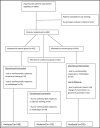Effects of continuous and interval training programs in the management of hypertension: a randomized controlled trial
- PMID: 21054770
- PMCID: PMC8816431
- DOI: 10.1111/j.1751-7176.2010.00315.x
Effects of continuous and interval training programs in the management of hypertension: a randomized controlled trial
Abstract
The purpose of the present study was to determine and compare the effect of interval and continuous training programs in the management of hypertension. Three hundred fifty-seven male patients with essential hypertension were age matched and grouped into interval, continuous, and control groups. The interval (n=140; 58.90±7.35 years) and continuous (n=112; 58.63±7.22 years) groups were involved in 8 weeks of interval (60%-79% maximum heart rate) and continuous (60%-79% maximum heart rate) programs of between 45 to 60 minutes, while the control group (n=105; 58.27±6.24 years) remained sedentary during this period. Findings of the study revealed significant effect of both training programs on maximum oxygen consumption, systolic blood pressure, diastolic blood pressure, heart rate, pulse pressure, and mean arterial pressure at P<.05. The maximum oxygen consumption significantly and negatively correlated with systolic blood pressure, diastolic blood pressure, rate-pressure product, pulse pressure, and mean arterial pressure at P<.01. It was concluded that both training programs are effective adjunct nonpharmacological management of hypertension. The recommendation of the paper was that both interval and continuous training programs should form part of the kit in the management of hypertension.
© 2010 Wiley Periodicals, Inc.
Figures
Similar articles
-
Comparative effect of interval and continuous training programs on serum uric acid in management of hypertension: a randomized controlled trial.J Strength Cond Res. 2011 Mar;25(3):719-26. doi: 10.1519/JSC.0b013e3181d09edf. J Strength Cond Res. 2011. PMID: 20574413 Clinical Trial.
-
Effect of interval training programme on pulse pressure in the management of hypertension: a randomized controlled trial.Afr Health Sci. 2013 Sep;13(3):571-8. doi: 10.4314/ahs.v13i3.7. Afr Health Sci. 2013. PMID: 24250291 Free PMC article. Clinical Trial.
-
Effect of low intensity continuous training programme on serum uric acid in the non pharmacological management of hypertension: a randomized controlled trial.Niger J Med. 2010 Jan-Mar;19(1):77-86. doi: 10.4314/njm.v19i1.52485. Niger J Med. 2010. PMID: 20232761 Clinical Trial.
-
The effect of regular aquatic exercise on blood pressure: A meta-analysis of randomized controlled trials.Eur J Prev Cardiol. 2018 Jan;25(2):190-199. doi: 10.1177/2047487317731164. Epub 2017 Sep 15. Eur J Prev Cardiol. 2018. PMID: 28914562 Review.
-
Cardiac reinnervation affects cardiorespiratory adaptations to exercise training in individuals with heart transplantation.Eur J Prev Cardiol. 2020 Jul;27(11):1151-1161. doi: 10.1177/2047487319880650. Epub 2019 Oct 11. Eur J Prev Cardiol. 2020. PMID: 31604403 Review.
Cited by
-
Effect of High-Intensity interval training versus moderate continuous training on 24-h blood pressure profile and insulin resistance in patients with chronic heart failure.Intern Emerg Med. 2014 Aug;9(5):547-52. doi: 10.1007/s11739-013-0980-4. Epub 2013 Jul 16. Intern Emerg Med. 2014. PMID: 23857036 Clinical Trial.
-
Kinetics of Hypotension during 50 Sessions of Resistance and Aerobic Training in Hypertensive Patients: a Randomized Clinical Trial.Arq Bras Cardiol. 2017 Apr;108(4):323-330. doi: 10.5935/abc.20170029. Epub 2017 Mar 30. Arq Bras Cardiol. 2017. PMID: 28380132 Free PMC article. Clinical Trial.
-
Effects of endurance, circuit, and relaxing training on cardiovascular risk factors in hypertensive elderly patients.Age (Dordr). 2015 Oct;37(5):101. doi: 10.1007/s11357-015-9835-4. Epub 2015 Sep 17. Age (Dordr). 2015. PMID: 26381921 Free PMC article. Clinical Trial.
-
Non-pharmacological interventions to achieve blood pressure control in African patients: a systematic review.BMJ Open. 2022 Feb 28;12(2):e048079. doi: 10.1136/bmjopen-2020-048079. BMJ Open. 2022. PMID: 35228272 Free PMC article.
-
Effects of aerobic exercise training on psychosocial status and serum uric Acid in men with essential hypertension: a randomized controlled trial.Ann Med Health Sci Res. 2012 Jul;2(2):161-8. doi: 10.4103/2141-9248.105665. Ann Med Health Sci Res. 2012. PMID: 23439606 Free PMC article.
References
-
- Jean‐Michel M, Bernard C, Roland A, et al. Twenty four hour ambulatory blood pressure monitoring efficacy of peridopril/Indapamide first line combination in hypertensive patients. Am J Hypertens. 2004;17:245–251. - PubMed
-
- Benegas JR. Epidemiologia de la hypertension arterial en Espana. Prevalencia, conocimneto Y control. Hypertension. 1999;16:315–322.
-
- Chobanian AV, Bakris GL, Black HR, et al. The Seventh Report of the Joint National Committee on prevention, Detection Evaluation and Treatment of high blood pressure. The JNC 7 report. JAMA. 2003;289:2560–2572. - PubMed
-
- Guidelines Committee European Society of Hypertension European Society of Cardiology . Guidelines for the management of arterial hypertension. J Hypertens. 2003;21:1011–1053. - PubMed
-
- Grossman E, Grossman A, Schein MH, et al. Breathing control lowers blood pressure. J Human Hypertens. 2001;15:263–269. - PubMed
Publication types
MeSH terms
LinkOut - more resources
Full Text Sources
Medical



